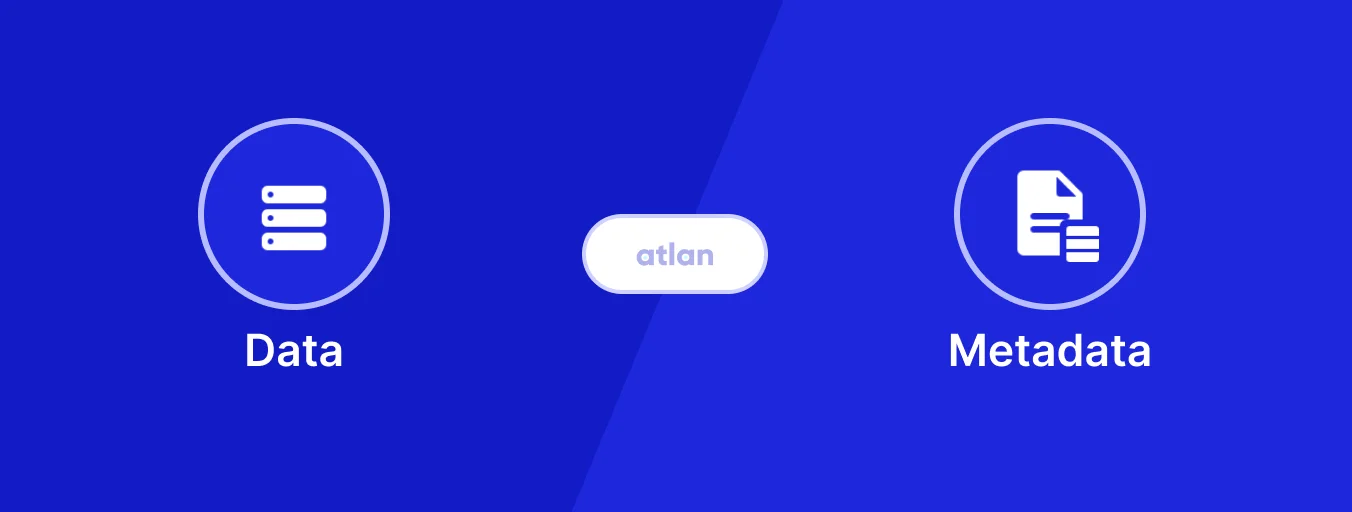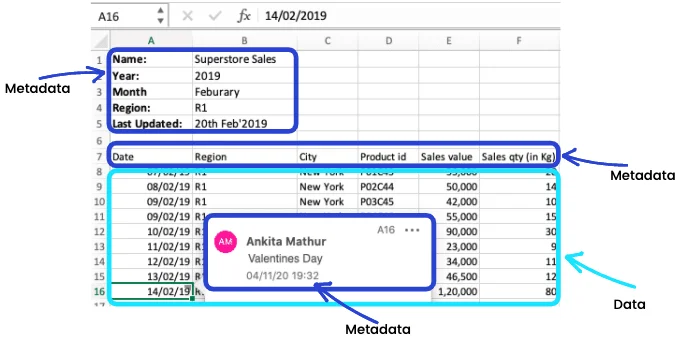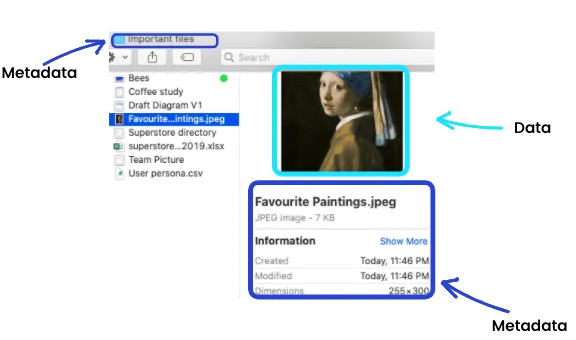Data Vs Metadata: 4 Key Differences, Examples & Common challenges

Share this article
What is the difference between data and metadata? #
The main difference between data and metadata lies in how we use the two pieces of information. Data is a set of raw facts that help identify useful information when they are cleaned, processed, and organized. Metadata, on the other hand, is data about data.
If data is the new oil, metadata is the refinery. Without metadata, there is no way to understand or use the data in hand.
See How Atlan Streamlines Metadata Management – Start Tour
Here’s a table that highlights the differences between data and metadata.
4 Key differences between data and metadata #
| Factors | Data | Metadata |
|---|---|---|
| Use | Data helps in gathering insights and discovering hidden patterns. | Metadata helps in understanding the data comprehensively. |
| Value | Data may or may not prove to be of value. | Metadata is always valuable. |
| Processing | Data doesn’t have to be processed before it is stored. | Metadata is always stored as processed information. |
| Management | Data’s storage and management are dependent on its type and use case. | Data admins can make metadata management generic across an enterprise, regardless of the data type or its use case. |
| Example | This blog is a piece of data, which explains the differences between data and metadata. | Metadata for this blog includes the author, publishing date, and total number of words. |
Table of contents #
- What is the difference between data and metadata?
- 4 Key differences between data and metadata
- Examples of data and metadata
- Common challenges with Metadata
- Summary of data vs metadata
- Data and metadata: Related reads
To understand the difference better, let’s start with defining data and metadata.

Data vs Metadata. Source: Atlan
Data is a set of raw facts that help identify useful information when they are cleaned, processed, and organized. For example, analyzing sales data can help a business identify trends or gaps and predict future possibilities. Without data, it’s not possible to get this information accurately or in a timely manner.
Metadata, on the other hand, is data about data. It helps people understand the essential attributes of data, like its origin, time period, geographic coverage, etc.
Metadata also includes the human tribal knowledge associated with data assets. It gives information about the data, without even opening it. Without this contextual information, you will not be able to extract the maximum value from your data assets.
The most common metadata examples are:
- Title
- Description
- Tags or categories
- Date of creation
- Who created it
- Source or origin
- Count and description of variables or attributes (e.g. rows and columns count for a data table)
Want to learn more about metadata? Read this article: What is Metadata?
Examples of data and metadata #
Let’s look at a few examples of data and metadata to understand the difference better.
1. An Excel spreadsheet #

Data vs Metadata in Spreadsheet. Source: Atlan
Here are some common metadata fields in a spreadsheet:
- File name
- Tab name
- Column names
- Number of rows
- Number of columns
- Comments
2. Files on our computer #

Data vs Metadata in a file on our computer. Source: Atlan
Here are some common metadata fields in a data system:
- Folder name
- Type of file
- Created date
- Last modified date
- Dimensions
- File size
Common challenges with metadata #
Most of us are aware of the role metadata plays in adding value to data. Without metadata, drawing inferences from data will be like shooting in the dark. However, since metadata is difficult to manage, businesses get stuck at actually implementing it. Even in the businesses that invest in creating and managing metadata, metadata’s ROI often doesn’t live up to expectations.
It’s a vicious cycle — as businesses struggle with metadata, they invest less time in it, making it less valuable and more difficult. However, to improve the quality of data management and make data useful, businesses must address metadata challenges.
Here are some key challenges in managing metadata:
-
Manual enrichment: Enriching metadata is a manual process, hence it takes time and dedicated energy from someone on staff.
-
Missing metadata: The documents that store metadata can get misplaced, leading to missing metadata.
-
Discovery: It can be very difficult to search through the existing metadata files. Sometimes, even good metadata management systems aren’t search-friendly.
-
Regular updates: After the metadata is created, it requires dedicated efforts to keep it up to date. The management system needs to create enough incentives for the steward or data manager to keep adding new metadata.
-
Separation of data and metadata: Metadata is usually stored away from the data. This reduces its value to provide context when it’s needed the most.
It is time that we start addressing data and metadata challenges separately, as their nature and use are different for businesses.
However, this does not mean that we have to keep data and metadata separate. In fact, it’s critical to bring them as close to each other as possible to avoid information silos.
Data Vs Metadata - Atlan Case study: Metadata Management at WeWork
Summary of data vs metadata #
Data and metadata go hand in hand. The closer we bring metadata to the actual data workings, the easier and quicker it will be to derive context for data. This will also solve for demonstrating the ROI of maintaining metadata.
As HDI said, “If data is the new oil, metadata is the refinery”. Without metadata, there is no way to understand or use the data in hand.
Want to know more about Atlan’s metadata management solution? Book a call with Atlan Team
Data vs Metadata: Related reads #
- 6 Types of Metadata, Examples, and their Use Cases
- What is Metadata? — Examples, Benefits, and Use Cases
- Data Vs Metadata - Differences, Examples & Common challenges
- Data Catalog: Does Your Business Really Need One?
- What is the difference between data catalog and metadata management?
- Metadata management 101: Benefits, tools, and best practices
- 6 metadata management best practices to follow in 2024
- Enterprise metadata management and its importance in the modern data stack
Share this article









